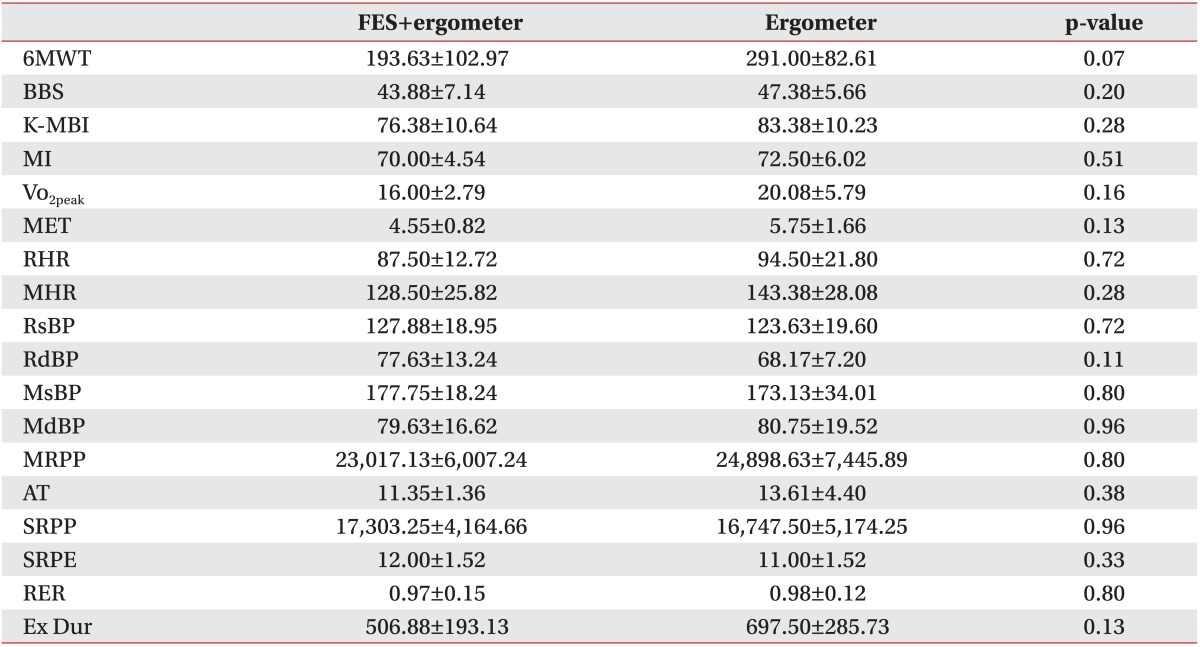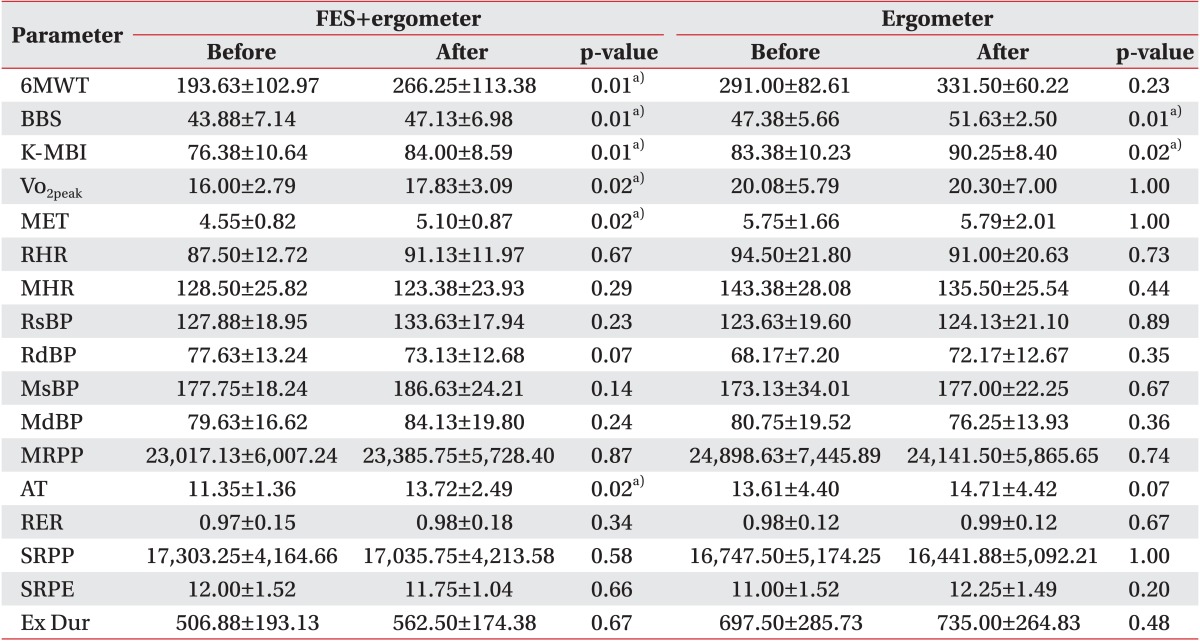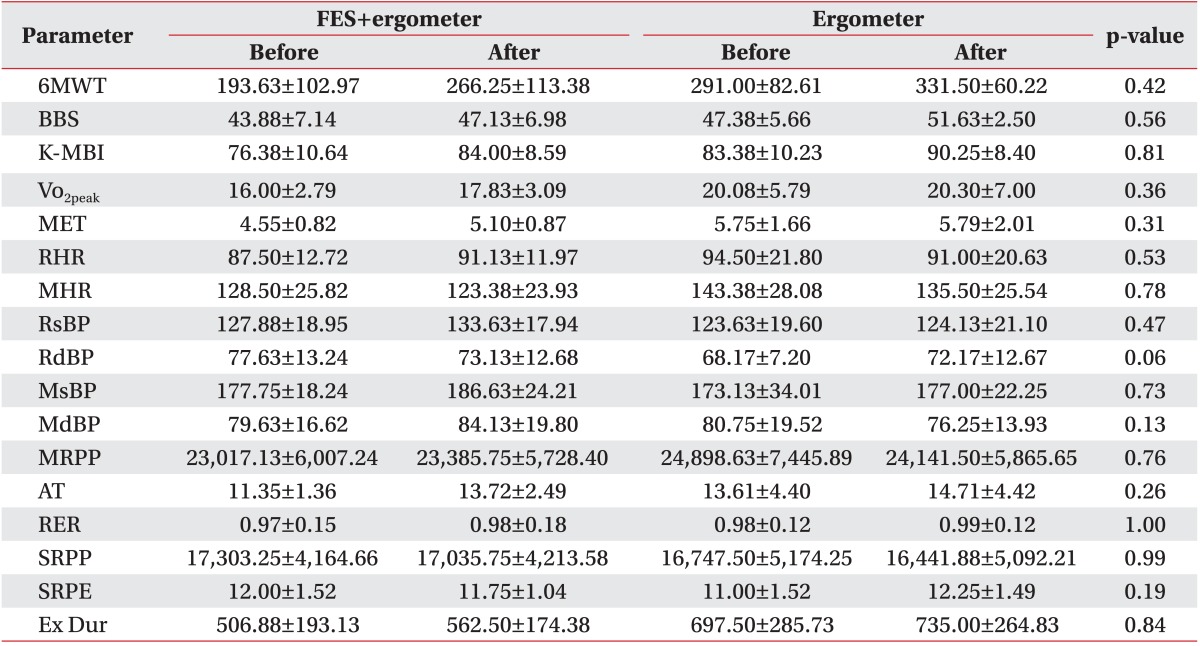1. Bobath B. Adult hemiplegia: evaluation and treatment. 3rd ed. London: Butterworth-Heinemann;1990.
2. Gresham GE, Fitzpatrick TE, Wolf PA, McNamara PM, Kannel WB, Dawber TR. Residual disability in survivors of stroke: the Framingham study. N Engl J Med. 1975; 293:954–956. PMID:
1178004.
3. Brown DA, Kautz SA. Increased workload enhances force output during pedaling exercise in persons with poststroke hemiplegia. Stroke. 1998; 29:598–606. PMID:
9506599.

4. Mayo NE, Wood-Dauphinee S, Ahmed S, Gordon C, Higgins J, McEwen S, et al. Disablement following stroke. Disabil Rehabil. 1999; 21:258–268. PMID:
10381238.
5. Szecsi J, Krewer C, Muller F, Straube A. Functional electrical stimulation assisted cycling of patients with subacute stroke: kinetic and kinematic analysis. Clin Biomech (Bristol, Avon). 2008; 23:1086–1094.

6. Jorgensen HS, Nakayama H, Raaschou HO, Olsen TS. Stroke: neurologic and functional recovery the Copenhagen Stroke Study. Phys Med Rehabil Clin N Am. 1999; 10:887–906. PMID:
10573714.
7. Hwang IS, Lee HM, Cherng RJ, Chen JJ. Electromyographic analysis of locomotion for healthy and hemiparetic subjects: study of performance variability and rail effect on treadmill. Gait Posture. 2003; 18:1–12. PMID:
12855295.
8. Janssen TW, Beltman JM, Elich P, Koppe PA, Konijnenbelt H, de Haan A, et al. Effects of electric stimulation-assisted cycling training in people with chronic stroke. Arch Phys Med Rehabil. 2008; 89:463–469. PMID:
18295624.

9. Hunt KJ, Stone B, Negard NO, Schauer T, Fraser MH, Cathcart AJ, et al. Control strategies for integration of electric motor assist and functional electrical stimulation in paraplegic cycling: utility for exercise testing and mobile cycling. IEEE Trans Neural Syst Rehabil Eng. 2004; 12:89–101. PMID:
15068192.

10. Takahashi T, Takazawa M, Nishiyama Y, Nakano E, Handa Y. FES cycling chair for the lower limbs disabled people with electric motor power assis. In : Proceedings of the 9th Annual International FES Society Conference; 2004 Sep 6-9; Bournemouth, UK. p. 247–249.
11. Raasch CC, Zajac FE. Locomotor strategy for pedaling:muscle groups and biomechanical functions. J Neurophysiol. 1999; 82:515–525. PMID:
10444651.
12. Hancock NJ, Shepstone L, Winterbotham W, Pomeroy V. Effects of lower limb reciprocal pedalling exercise on motor function after stroke: a systematic review of randomized and nonrandomized studies. Int J Stroke. 2012; 7:47–60. PMID:
22111955.

13. Potempa K, Lopez M, Braun LT, Szidon JP, Fogg L, Tincknell T. Physiological outcomes of aerobic exercise training in hemiparetic stroke patients. Stroke. 1995; 26:101–105. PMID:
7839377.

14. Brown DA, Kautz SA, Dairaghi CA. Muscle activity adapts to anti-gravity posture during pedalling in persons with post-stroke hemiplegia. Brain. 1997; 120(Pt 5):825–837. PMID:
9183253.

15. Holt R, Kendrick C, McGlashan K, Kirker S, Jenner J. Static bicycle training for functional mobility in chronic stroke: case report. Physiotherapy. 2001; 87:257–260.
16. Fujiwara T, Liu M, Tanuma A, Hase K, Tsuji T. Pedaling exercise for neuromuscular re-education: a review. Crit Rev Phys Rehabil Med. 2005; 17:163–178.

17. Katz-Leurer M, Sender I, Keren O, Dvir Z. The influence of early cycling training on balance in stroke patients at the subacute stage: results of a preliminary trial. Clin Rehabil. 2006; 20:398–405. PMID:
16774090.

18. Quaney BM, Boyd LA, McDowd JM, Zahner LH, He J, Mayo MS, et al. Aerobic exercise improves cognition and motor function poststroke. Neurorehabil Neural Repair. 2009; 23:879–885. PMID:
19541916.

19. Katz-Leurer M, Carmeli E, Shochina M. The effect of early aerobic training on independence six months post stroke. Clin Rehabil. 2003; 17:735–741. PMID:
14606739.

20. Sheffler LR, Chae J. Neuromuscular electrical stimulation in neurorehabilitation. Muscle Nerve. 2007; 35:562–590. PMID:
17299744.

21. Lee SY, Im SH, Kim BR, Choi JH, Lee SJ, Han EY. The effects of neuromuscular electrical stimulation on cardiopulmonary function in healthy adults. Ann Rehabil Med. 2012; 36:849–856. PMID:
23342319.

22. Kesar TM, Perumal R, Jancosko A, Reisman DS, Rudolph KS, Higginson JS, et al. Novel patterns of functional electrical stimulation have an immediate effect on dorsiflexor muscle function during gait for people poststroke. Phys Ther. 2010; 90:55–66. PMID:
19926681.

23. Santos M, Zahner LH, McKiernan BJ, Mahnken JD, Quaney B. Neuromuscular electrical stimulation improves severe hand dysfunction for individuals with chronic stroke: a pilot study. J Neurol Phys Ther. 2006; 30:175–183. PMID:
17233925.
24. Petrofsky JS, Phillips CA. The use of functional electrical stimulation for rehabilitation of spinal cord injured patients. Cent Nerv Syst Trauma. 1984; 1:57–74. PMID:
6400201.

25. Petrofsky JS, Laymon M. The effect of previous weight training and concurrent weight training on endurance for functional electrical stimulation cycle ergometry. Eur J Appl Physiol. 2004; 91:392–398. PMID:
14618331.

26. Petrofsky JS, Stacy R. The effect of training on endurance and the cardiovascular responses of individuals with paraplegia during dynamic exercise induced by functional electrical stimulation. Eur J Appl Physiol Occup Physiol. 1992; 64:487–492. PMID:
1618183.

27. Hooker SP, Scremin AM, Mutton DL, Kunkel CF, Cagle G. Peak and submaximal physiologic responses following electrical stimulation leg cycle ergometer training. J Rehabil Res Dev. 1995; 32:361–366. PMID:
8770800.
28. Skold C, Lonn L, Harms-Ringdahl K, Hultling C, Levi R, Nash M, et al. Effects of functional electrical stimulation training for six months on body composition and spasticity in motor complete tetraplegic spinal cord-injured individuals. J Rehabil Med. 2002; 34:25–32. PMID:
11900259.
29. Nash MS, Montalvo BM, Applegate B. Lower extremity blood flow and responses to occlusion ischemia differ in exercise-trained and sedentary tetraplegic persons. Arch Phys Med Rehabil. 1996; 77:1260–1265. PMID:
8976309.

30. Raymond J, Schoneveld K, Van Kemenade CH, Davis GM. Onset of electrical stimulation leg cycling in individuals with paraplegia. Med Sci Sports Exerc. 2002; 34:1557–1562. PMID:
12370555.

31. Raymond J, Davis GM, Climstein M, Sutton JR. Cardiorespiratory responses to arm cranking and electrical stimulation leg cycling in people with paraplegia. Med Sci Sports Exerc. 1999; 31:822–828. PMID:
10378909.

32. Buchfuhrer MJ, Hansen JE, Robinson TE, Sue DY, Wasserman K, Whipp BJ. Optimizing the exercise protocol for cardiopulmonary assessment. J Appl Physiol. 1983; 55:1558–1564. PMID:
6643191.

33. Macko RF, Katzel LI, Yataco A, Tretter LD, DeSouza CA, Dengel DR, et al. Low-velocity graded treadmill stress testing in hemiparetic stroke patients. Stroke. 1997; 28:988–992. PMID:
9158639.

34. Ferrante S, Pedrocchi A, Ferrigno G, Molteni F. FES cycling treatment on hemiplegic patients: preliminary results. In : Proceedings of the 11th Annual International FES Society Conference; 2006 Sep 12-15; Miyagi-Zao, Japan. p. 77–79.
35. Ferrante S, Pedrocchi A, Ferrigno G, Molteni F. Cycling induced by functional electrical stimulation improves the muscular strength and the motor control of individuals with post-acute stroke. Europa Medicophysica-SIMFER 2007 Award Winner. Eur J Phys Rehabil Med. 2008; 44:159–167. PMID:
18418336.
36. Ambrosini E, Ferrante S, Pedrocchi A, Ferrigno G, Molteni F. Cycling induced by electrical stimulation improves motor recovery in postacute hemiparetic patients: a randomized controlled trial. Stroke. 2011; 42:1068–1073. PMID:
21372309.
37. Lo HC, Hsu YC, Hsueh YH, Yeh CY. Cycling exercise with functional electrical stimulation improves postural control in stroke patients. Gait Posture. 2012; 35:506–510. PMID:
22153770.

38. Smart NA, Dieberg G, Giallauria F. Functional electrical stimulation for chronic heart failure: a meta-analysis. Int J Cardiol. 2013; 167:80–86. PMID:
22236510.








 PDF
PDF ePub
ePub Citation
Citation Print
Print



 XML Download
XML Download